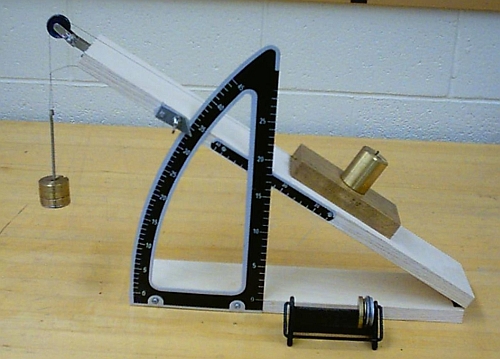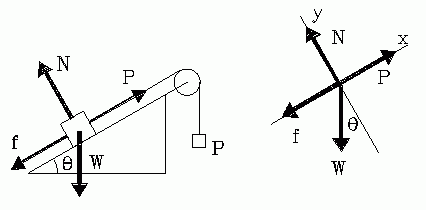M-2 FRICTION AND THE INCLINED PLANE
(1) To measure the coefficient of friction for several combinations of materials, making use of an inclined plane. (2) To study equilibrium and non-equilibrium of a body on an inclined plane under the action of forces. 2. APPARATUS Inclined plane, wooden block, small cart with wheels, weight hanger, set of weights, clock timer, meter stick. Some versions of the apparatus have wooden planes, some have enameled metal. 3. BACKGROUND Discussion of friction, and problems about motion on an inclined plane, will be found in any general physics textbook. The basic relation for friction is:
Maximum force due to static friction = fs = μsN and
Force due to kinetic friction = fk = μkN where μs and μk are proportionality constants, called respectively, the coefficient of static friction, and the coefficient of kinetic friction. Following the usual notation, the forces acting on a body on an inclined plane are shown in figure 1. W is the weight of the body (W = mg), N is the normal force due to the plane, f is the frictional force, and P is the applied force present when a string is attached to the body to pull it up the plane. Generally this situation is analyzed by resolving the forces into components parallel and perpendicular to the plane, as shown in Fig. 2. The components of the weight are:
W = Wx sin θ
W = Wy cos θ
4. PROCEDURE Note to students: A large amount of data will be taken in this experiment. To aid you in organizing this data, special data sheets are included. (1) Starting friction on level plane. Lay the wooden block on the plane with its large face down. Apply a force, P, to it by means of a string running over a pulley to a weight hanger. Add weights to the hanger until the block begins to move. In this way determine the approximate value of starting friction. Determine the value more accurately by starting just below this value and adding weight in very small increments. The error may be estimated by noting the smallest additional weight which produces motion.
REMINDERS: You must weigh the wooden block. The string must always be parallel to the plane. (2) Sliding friction on level plane. With weight on the block as before, give the block a push to overcome starting friction and remove weights from hanger until the block slides with nearly constant velocity. There will be quite a lot of uncertainty in determining whether the velocity is constant, so take some care in doing this. Determine carefully the value of the uncertainty in P due to this cause. In some cases it may be necessary to clean the plane with detergent. Do not touch the plane with your hands, for body oil will cause slick spots. (3) Equilibrium on the Inclined Plane. Investigate both starting friction and sliding friction at different plane angles. Use angles of 15°, 25°, 35°, and 45°. (You have already done this for 0°.) At each angle, investigate the situation with different values of W, including the following cases: A) no weight on block, B) 100 grams on block. C) 200 grams on block, and if there is time, D) 500 grams on block. (4) Non-equilibrium. For this part, use the long plane. Two plane angles will be investigated, 0° and 30°. Determine the force, P, necessary to produce acceleration up the plane at a rate convenient to measure with the clock timer. Measure the time to accelerate from rest along a measured distance of the plane. An easy way to do this is to use a distance of one meter: Start with the bottom of the weight hanger exactly one meter from the floor. Release the hanger as you start the timer, and stop the timer the instant the hanger touches the floor. Practice the timing operation until you can do it with reproducible results. Do the same for acceleration down the plane. (5) Free body on plane. Remove the cord which applied the force, P. Use various combinations of weights on the body to produce the following experimental situations.
(6) [Instructor's option] Carry out an investigation as in (1) through (3) using the small four-wheeled cart in place of the block. Use the same combinations of plane angle and cart load as suggested there. The friction is very much smaller than with the block; and you must be very careful to reduce sources of error to obtain a good measurement of the friction in the wheels. Note that the friction in the wheels may be comparable in size to the friction in the pulley at the top of the plane. Some ingenuity on your part will be require to make sense of the data. 5. ANALYSIS Part 1-4 of the experiment yield values for the coefficient of friction for two distinct pairs of surfaces: (1) wood sliding on the plane, and (2) wheels rolling on the plane. Theory predicts that each coefficient of friction should be constant. Your experimental values may show quite a bit of variation, however. Is this variation due to random error, or is there a residual discrepancy due to systematic error? To answer this question, you must do an error analysis. The contribution of random error is easily calculable from the error in your data by standard error propagation formulae. The equation used was
The error in sin θ may be obtained from a table of sines. For example, if your angle was 25° ± 0.5°, look up in the table the values of sin 25°; sin 24.5°, and sin 25.5° to get the range of uncertainty in sin 25°. The range of uncertainty will be different for each angle you used! The dominant source of error in this equation will probably be the error involved in taking the difference: P - W sin θ. Verify this with your own error analysis. Compare your calculated probable error in μ with the average deviation of your experimental values of μ. If the average deviation is greater than the probable error, you probably have a systematic error present. Inspect the variation in μ in your data. Is μ dependent on any other data quantity? If so, which one? Try graphing this dependence, indicating the probable error in each value of μ with an error flag. Is this dependence of any simple form? Can you suggest any physical reason for such a dependence? 6. QUESTIONS (1) Would the coefficient of friction of a 3-wheeled car be less than that of a 4 wheeled car, assuming the cars weighed the same, and the wheels were the same? Calculate the ratio of the values of friction coefficient in the two cases. (2) Consider the pulley at the top of the plane. How does the friction in the pulley depend on the tension in the string and the angle of the plane? State your assumptions clearly, and derive the equation for the pulley friction. (3) The angle of uniform slip is that angle of the plane which causes the free block to slide down the plane with constant velocity. Show that this angle is given by
tanθ = μk where μk is the coefficient of kinetic friction. Text and drawings © 1989, 2004 by Donald E. Simanek. |

